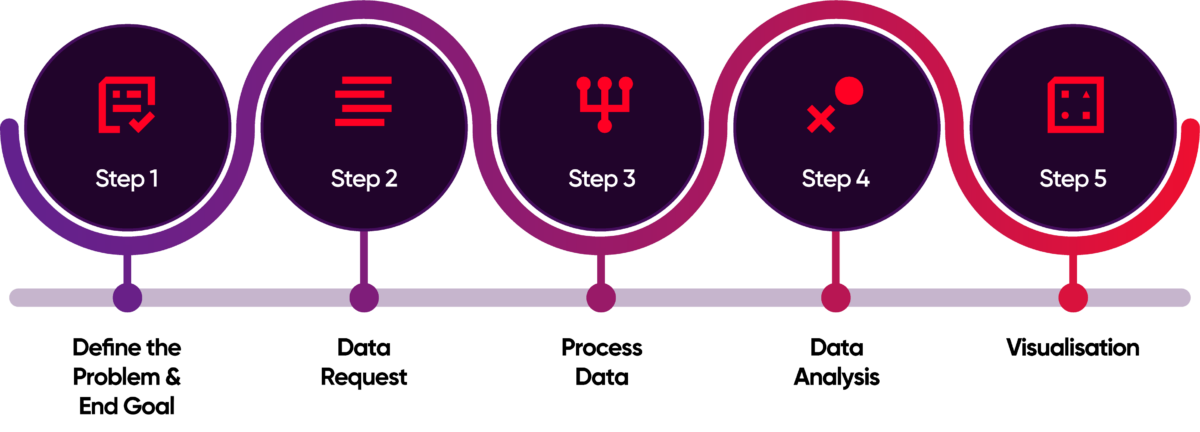This website uses cookies so that we can provide you with the best user experience possible. Cookie information is stored in your browser and performs functions such as recognising you when you return to our website and helping our team to understand which sections of the website you find most interesting and useful.

Data Analysis of the Customer Journey
Delivering fantastic customer experience (CX) has become more important than ever to organisations after the pandemic, with 86% of consumers revealing that they would pay more for a brand delivering great customer experience.
Our team of professional CX practitioners have worked across a range of industries for customers of all sizes to deliver real, tangible benefits to both the organisations and the clients they serve.
On this page we want to show you the role that data plays in our transformation consultancy and the steps we take to get insights from your data.
Why Understanding Data is
Important for Customer Experience
By understanding the concept of customer journey mapping as a visual representation of the end-to-end customer experience, organisations can gain valuable insights into their customers’ needs, expectations, and pain points.
A customer journey map illustrates the various stages, touchpoints, and interactions a customer goes through while engaging with your brand. This visual representation provides context and helps businesses identify critical moments in the customer journey, enabling them to make targeted improvements and deliver a more personalised and seamless experience.
By mapping the customer journey, organisations can develop a deeper understanding of their customers. They can uncover the path customers take, the touchpoints they encounter, and the interactions they have with the brand. This understanding allows businesses to identify pain points and areas for improvement, ultimately leading to a better customer experience.

Just 39% of executives believe their organisations manage data as an asset, and even fewer (24%) view their companies as being data-driven. A 2021 survey, also found that just 13% of executives believe their organisations are delivering on their data strategy.
2021 study by NewVantage
Key Components of a Customer Journey Map
A customer journey map is a valuable tool for understanding and improving the customer experience. It consists of several key components that work together to provide a holistic view of the customer's interactions with a brand.
Touchpoints, Stages, and Customer Personas
FourNet are industry leaders in Enterprise networking. Our vendor-agnostic networks inherently have Performance and Availability ‘by design’. Inherently secure, we extend our security fabric end-to-end to support very sensitive traffic and enable you to meet regulatory and industry-specific Compliance requirements. Multiple Branches can be added with Zero Touch Provisioning, all managed from a single pane of glass at FourNet 24/7 NOC providing you with agility, scalability & flexibility.
Capturing Interactions and Touchpoints
It is crucial to identify and map all customer touchpoints to gain a comprehensive understanding of their journey. By capturing customer interactions at each touchpoint, businesses can evaluate the quality of these interactions and identify areas for improvement. This includes analysing website behaviour, tracking social media engagement, monitoring customer service interactions, and reviewing purchase data. Mapping customer interactions helps identify pain points, moments of delight, and opportunities to create memorable experiences.
Mapping Emotions and Expectations
Emotions and expectations play a significant role in shaping the customer experience. It is essential to capture and understand these at each stage of their journey. Techniques such as surveys, feedback forms, and sentiment analysis of customer interactions can help assess customer sentiment. By mapping emotional highs and lows, businesses can identify critical moments of impact and tailor their strategies to meet customer expectations effectively.
Incorporating Feedback and Insights
Customer feedback and insights are invaluable for refining and improving the customer journey map. Gathering feedback through surveys, interviews, and user testing helps businesses gain a deeper understanding of customer preferences, pain points, and opportunities for enhancement. These insights can be used to validate and refine the journey map, ensuring its accuracy and relevance. The process of refining the map should be iterative, with ongoing feedback and continuous improvement at its core.
Creating an Omnichannel Customer Journey Map
To provide a seamless and consistent customer experience, it is essential to consider the customer's journey across multiple channels and devices. This includes websites, mobile apps, social media platforms, and physical locations. Creating an omnichannel customer journey map presents challenges in terms of data integration, channel coordination, and maintaining a cohesive experience. However, the benefits include a more comprehensive understanding of the customer journey and the ability to deliver a unified and personalised experience across all touchpoints.
Best Practices for Customer
Journey Mapping
To create effective customer journey map, it is essential to follow best practices that ensure accuracy, collaboration, and ongoing relevance. Here are some tips to consider:
Create a comprehensive customer experience data diagnosis by engaging cross-functional teams and stakeholders, gathering qualitative data through customer research, and validating with real users. Regularly update and refine the journey map to reflect changing customer expectations. Integrate the insights into business decision-making, aligning marketing, product development, and customer service initiatives with the customer journey. This user-centric approach ensures accurate mapping and creates customer-centric experiences that exceed expectations.

Our Five Step Data Diagnostic Approach
Define the Problem & End-Goal
Before we start our data analysis, we need to understand the challenges you are facing and the outcome that you want to achieve through the CX transformation. This could be as simple as reducing call handle time, but having a clear understanding of the problems you're having will allow us to refine our data analysis.
Data Request
We request a tailored set of data, to support our analysis, that should be transferred to us and stored securely using your specific protocols that will meet our ISO27001 management system, in line with your specific needs and requirements.
Process Data
Once the data is received, we establish volume of records, check each field within the data set to identify anything erroneous. Does the data received help support what we are looking to solve (step 1). This may result in either re defining the problem statement or additional data being requested.
Data Analysis
Our data analysts dive into the data applying extensive industry specific knowledge and layering the different data sets to identify possible root causes.
Visualisation
The outputs of the analysis are presented in an accessible, easily digestible interactive format and the areas driving highest customer effort and pain are called out. This is played back to the CX service design team ahead of final agreement of the focus of the onsite activity to add an additional lens and deeper understanding to the findings and contribute to possible causes. Any additional areas of further analysis are also identified ahead of customer playback.
Want More Detail?
Learn more about each stage of the data diagnosis process and learn why data is so important to customer experience.
Why Work With FourNet to Transform Your CX
Our team of professional CX practitioners have worked across a range of industries for clients of all sizes to deliver real, tangible benefits to both the organisations and the clients they serve. Most recently implementing real time voice analytics technology to deliver call handling time efficiencies, automation of the quality monitoring framework on the spoken elements of the call, increases sales, but most importantly supporting vulnerable customers.

Book a Free Data Diagnostic
Enter your details here and we will be in touch to kick off your data diagnosis.
